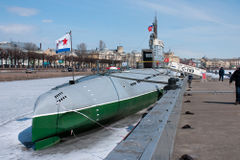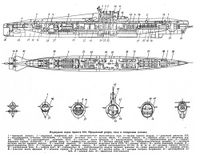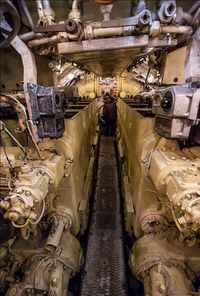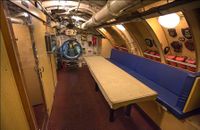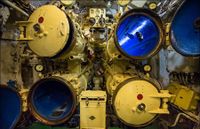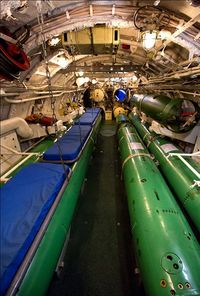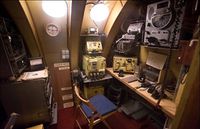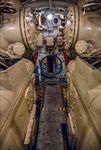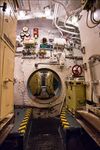S-189 (1954)
S-189
| 04.09.1954 Launched |
| 09.03.1955 Delivered |
| Withdrawn from боевого состава |
| 1080 / 1350 etc. Displacement (surface / underwater) |
| 76 / 6.6 / 4.55 m. Dimensions (length/width/draft) |
| 170 / 200 m. Immersion depth (working/limit) |
| 30 days Autonomy (max) |
| 52 чел. Общая численность |
216 units
[[Category:]]

Contents
General information
After the end of World War II USSR was set a large-scale goal - to ensure the security of the sea border of USSR Navy with modern warships that are able to withstand the most powerful countries , representing a military-political threat to the USSR, as well as surpassing them - this is like USA and its allies. In many design bureaus of the Soviet Union, work began on the development of the latest submarines, which have no analogues in the world. One of the many design bureaus was ЦКБ-18, where a completely new type of submarines was developed, called Project 613 submarines, under which PL S-189 was created.
History of creation
The first post-war diesel-electric submarine was the most massive project 613 submarine in the USSR Navy. The project was a development of the project 608 submarine of medium displacement, developed in 1942-1944. The S-189 submarine of project 613 was laid down on March 31, 1954 at the Baltic Shipyard. Ordzhonikidze in Leningrad.
Predecessors
Before World War II, the USSR built Pike_type submarines, which no longer met the modern realities of effective submarine warfare against ships and submarines of a potential enemy of the USSR.
Prerequisites for creation
World War II showed that the Soviet Union needed to approach the creation of new submarines more carefully, taking into account the experience of Soviet and foreign submarine construction of the fleet. In 1942, Soviet designers began work on a project for a new medium submarine, which was supposed to replace the aging Pike-class submarines. The submarine project received the number 608, but it did not come to its implementation in metal.
Design
At the end of 1944, the Soviet Navy received materials on the German submarine U-250, which was sunk in the Gulf of Finland and then raised from the bottom. This submarine had tactical and technical elements close to the Project 608 submarine. In January 1946, after studying the captured U-250 submarine. The Commander-in-Chief of the USSR Navy of the Main Directorate of Shipbuilding approved the tactical and technical assignment for the design of the project 613 submarine. It was proposed to change the tactical and technical characteristics of the project 608 in the direction of increasing the speed and cruising range while increasing the standard displacement to 800 tons. The design was entrusted to TsKB-18 (now TsKB MT Rubin). For the construction of the project 613 submarine, which included the S-189 submarine, the chief designer was appointed V.N. Peregudov, then Ya.E. Evgrafov, and since 1950 Z.A. Deribin. In August 1946, a tactical and technical assignment was issued for the Project 613 submarine, and on August 15, 1948, the technical design was approved by the Government of the USSR. When developing theoretical drawings, special attention was paid to ensuring high running performance in a submerged position. As a result, the maximum submerged speed increased to 13 knots, instead of 12.
Construction and testing
The S-189 submarine of project 613 was laid down on March 31, 1954 at the Baltic Shipyard. Ordzhonikidze in Leningrad. The construction of Project 613 submarines was carried out from 1950 to 1957. A total of 216 submarines were built. Submarine S-189 of project 613 was launched on September 4, 1954.
Design Description
Frame
Project 613 submarine is an all-welded durable hull with internal placement frames is divided by watertight bulkheads into 7 compartments:
- Torpedo. Shelter section.
- Rechargeable and residential.
- Central post. Shelter section.
- The second group of batteries, living quarters for foremen.
- Diesel.
- Electromotive.
- Torpedo. Shelter compartment.
For the first time in this project, frames specially designed for submarine shipbuilding were used, made from an asymmetric stripe bulb. The shape of its cross section provided the necessary ratio between the area and the moment of inertia, and the wall thickness was well combined with the thickness of the hull skin.
Power plant and driving performance
The main power plant of the submarine included 37D two-stroke diesel engines. There was a device RDP with mine and a float valve. Shaft line mechanisms were mounted on soundproof shock absorbers. The economic propulsion electric motor transmitted rotation to propeller shafts through elastic and silent textrope gears with a gear ratio of 1:3 and economic propulsion friction clutches. Between the diesel engines and HED there were tire-pneumatic disconnecting couplings and the same couplings between the HEM and thrust shafts, which were connected to the propeller shafts by rigid flanges. SHPRM were used due to the obvious advantage over BAMAG-type clutches installed on submarines of pre-war projects - they made it possible to soundproof diesel engines and the shaft line, to install the shaft line on slipway, and not after launching, as they allowed much larger breaks and displacement of the mating axes of individual parts of the shafting.
To ensure the operation of surface diesels at periscope depth, the S-189 submarine had an RDP device, which was a retractable shaft for supplying fresh air into the hull of the boat, which ensured the operation of the main engines. The air channel of this device was equipped with a float valve to prevent water from entering when its upper part was flooded or deepened, and exhaust gases were removed through a stationary shaft located in the aft part of the fence felling. For historical reference, it should be noted that the prototype of the RDP at the beginning of the 20th century was designed by the Russian submarine officer Gudim and installed on one of the Russian submarines. A few decades later, already as a proven model, a similar device became widely known under the name "snorkel".
Auxiliary equipment
The S-189 submarine had periscopes, RDP, vertical and horizontal rudders, and torpedo tube covers were hydraulically driven. For the first time in the Soviet Navy, boats of project 613 used a silent trim system (only with air), gas vents were installed with exhaust into the water directed to the stern (using the suction effect of the outboard water flow), for latrines sewage cylinders were installed.
Crew and Habitability
On the S-189 submarine of project 613, the crew number was 52 people.
Armament
The S-189 submarine of project 613 belonged to torpedo-artillery submarines.
Mine and torpedo armament
Torpedo armament included four bow 533mm TA and two aft 533mm TA. Number of spares torpedoes to the bow torpedoes was increased to 6 pieces, which was their total number of spare torpedoes.
Auxiliary/AA Artillery
Initially, the PL-189 of project 613 housed artillery weapons from one twin 57-mm SM-24-SIF machine gun and one twin 25-mm machine gun 2M-8. Later, all artillery weapons were removed from the submarine.
Communications, detection, auxiliary equipment
On the S-189 submarine of project 613, the main means of detection in a submerged position GAS "Tamir-5L" and GAS noise direction finding "Phoenix".
Modernizations and refurbishments
Submarine C-189 project 613 has not undergone significant modernization. From the beginning, there was the installation of new types of weapons and electronic equipment being adopted, as well as the introduction of design changes related to the improvement of construction technology. For example, initially the project provided for the use of steam-gas torpedoes of the type 53-38, 53-38U and 53-39 , as well as electric torpedoes ET-80, that is, pre-war and military samples. Later, as new samples were adopted, the former ones were replaced by more modern models: combined-cycle types 53-51, 53-56, 53-57, 53-61, as well as homing electric torpedoes of the SAET-50 and SET-56.
Service History
| Project 613 S-189 submarine service | |
|---|---|
| Year | Service |
| February 1, 1954 | Enlisted in the lists of ships of the Soviet Navy |
| February 1954 | Crew formed |
| March 31, 1954 | Laid down at the Baltic Shipyard named after S. Ordzhonikidze in Leningrad |
| September 4, 1954 | Launched into the water |
| November 2, 1954 | Start of mooring trials |
| December 20-23, 1954 | Exit to the test. Transition along the route Leningrad-Kronstadt-Hogland-Tallinn-Libava to the delivery base of the plant to complete mooring trials |
| December 28, 1954 | End of mooring trials |
| December 29, 1954-January 21, 1955 | Carried out the program of factory sea trials |
| January 9, 1955 | Raised the naval ensign. This day is considered a ship's holiday. |
| January 22 - March 9, 1955 | Fulfilled the program of state tests. Temporarily based in Libava |
| March 9 | Entered service |
| March 17, 1955 | Became part of the USSR Navy based in Ust-Dvinsk, then in Paldiski |
| February 15, 1955 | Reorganized into the East Baltic Flotilla based in Paldiski |
| May 20, 1956 | Transferred to the 158th Brigade of the 27th DiPL of the KBF based in Klaipeda |
| November 19, 1956 - April 30, 1957 | Was at plant No. 180 in Leningrad for the production of modernization work |
| July 1, 1957 | Transferred to the 417th division of the 177th brigade of experimental ships of the Leningrad Navy, based on Vladimirskaya Bay |
| October 14, 1958 | Transferred to the 39th ObrSRPL LenVMR. Based in Leningrad and Kronstadt |
| 1959 | The crew was awarded the honorary Red Banner of the Regional Council of the Komsomol |
| 1959 | Moved to a test site on Lake Ladoga to test new types of weapons and equipment |
| 1960 | When carrying out the test program, when diving under the support ship, the deckhouse fence touched the bottom of the ship. |
| May 5, 1965 | Transferred to the 116th ODnPL of the 4th UDik LenVMB based in Kronstadt |
| August 31, 1966 | Reorganized into the 25th SLBM of the 4th UDiK LenVMB with the same base |
| July 1968 | On the day of the 50th anniversary of the USSR Navy, it completed a special task in Leningrad on the Neva: on a signal, it plunged into position against the Mining Institute, passed under the Liteiny bridges and surfaced. When it caught up with the stern of the cruiser "Kirov", signal rockets were fired from the bow superstructure of the submarine |
| December 15, 1968 - April 29, 1969 | Transferred for winter basing in Liepaja and Baltiysk with temporary subordination to the commander of the 37th DiPL DKBF |
| December 24, 1969 - April 27, 1970 | Transferred for winter basing in Liepaja and Baltiysk with temporary subordination to the commander of the 37th DiPL DKBF |
| April 9, 1970 | By order of the commander of the Leningrad Naval Base, it was declared an "Excellent ship" |
| April 1970 | Took part in the maneuvers "Ocean" |
| 1970 | For excellent performance in combat and political training in 1970, she was included in the Book of Honor of the Leningrad Navy |
| January-May | Transferred for winter basing in Baltiysk |
| 1971 | Confirmed the title of "Excellent ship" |
| 1972 | Based in Liepaja. Participated in the exercises of the DCBF "Spring-72" and "Baltika-72" |
| 1972 | Confirmed the title of "Excellent ship" |
| January 31, 1973 - April 18, 1973 | Transferred for winter basing in Liepaja and Baltiysk with temporary subordination to the commander of the 37th DiPL DKBF |
| May to September 1975 | Completed a program of special tests of new types of weapons and equipment at the Ladoga Lake test site. |
| January - May 1976 | Transferred for winter basing in Baltiysk |
| January - April 29 | Worked out the tasks of the BP in the South Baltic based in the city of Baltiysk. Participated in the exercises of the DKBF "North-77" |
| July 1977 | Represented the formation at the celebration of the Day of the USSR Navy in Moscow |
| December 25, 1977 - April 29, 1978 | Worked out the tasks of the BP in the South Baltic based in Baltiysk |
| October 1978 | Took part in torpedo firing for the prize of the Civil Code of the Navy of the USSR. Shooting "excellent" took 2nd place in the Soviet Navy in torpedo training. By order of the commander of the 25-BrPL dated 11/03/1978 for participation in competitive torpedo firing for the prize of the Commander-in-Chief of the Navy, which were held for the first time in the history of the Leningrad Naval Base and for the worthy performance of duty by all personnel of the S-189 submarine ' thanks |
| 1978 | Recognized as the best ship of the connection |
| summer 1979 | Relocated to Lake Ladoga to participate in the testing of new types of weapons |
| December 12, 1979 - 1980 | Repaired at KMOLZ in Kronstadt |
| 1979 | Recognized as the best ship of the connection |
| 1982 | Recognized as the best ship of the connection |
| 1983 | Participated in the exercises of the DCBF under the leadership of the Civil Code of the Navy of the USSR |
| 1984 - July 1985 | Based in Paldiski |
| July 1985 | Took part in the parade on the Day of the Soviet Navy in Leningrad |
| September 1, 1986 | According to the directive of the Main Headquarters of the Navy of the USSR of March 14, 1986 and the directive of the Chief of Staff of the Leningrad Naval Base of April 15, 1986, it was put into reserve of the 3rd category and mothballed as part of the 25th BrPL in Kronstadt. Submarine care and conservation are entrusted to the 82nd submarine mothballing crew |
| April 19, 1990 | Excluded from the USSR Navy in connection with the surrender to the OFI for dismantling and sale (order of the Commander-in-Chief of the Navy dated 04/19/1990 and the commander of the Leningrad Naval Base dated 05/28/1990). Laid up in Kronstadt |
| October 1, 1990 | Crew disbanded |
| 1998 - 1999 | It sank due to a malfunction of the outboard fittings and was in a flooded state on the ground in the Merchant Harbor of Kronstadt near the pier |
| November 2005 | Raised and towed to the Kanonersky Zavod for conversion into a museum |
| June 22, 2006 | Taken out of the floating dock of the Kanonersky Zavod and placed against the wall to complete the interior restoration work |
| August 2, 2007 | Transferred and moored to the floating pier on the Lieutenant Schmidt Embankment opposite the Marine Corps of Peter the Great (former VVMU named after Frunze) in St. Petersburg for permanent mooring |
| August 3, 2007 | Solemn raising of the flag and opening of a floating monument-museum (underwater floating museum "PPM S-189" on the initiative of veteran organizations of submariners in St. Petersburg) |
| 2012 | Open to the public as a museum |
| 2019 | Used as a museum |
Commanders
Awards
Submarine C-189 received the title of "Excellent Ship". It was recognized more than once as the best ship of the formation.
See Also
Literature and sources of information
Literature
Links
- Project 613 submarines broken link?
